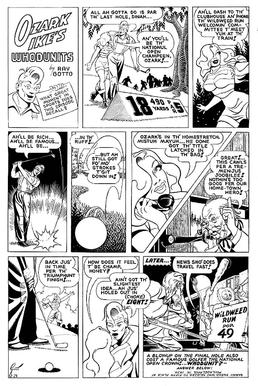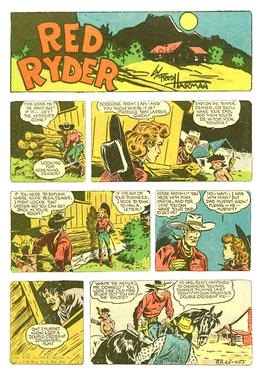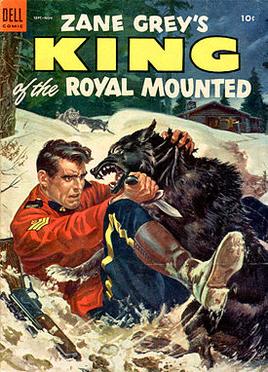
Ozark Ike is a newspaper comic strip about dumb but likable Ozark Ike McBatt, a youth from a rural area in the mountains. The strip was created by Rufus A. ("Ray") Gotto while he was serving in the Navy during World War II in Washington, D.C. as an illustrator for Navy instruction manuals. The strip ran from November 12, 1945, to September 14, 1958.

Red Ryder is a Western comic strip created by Stephen Slesinger and artist Fred Harman which served as the basis for a wide array of character merchandising. Syndicated by Newspaper Enterprise Association, the strip ran from Sunday, November 6, 1938, through 1965.

Frederic Sackrider Remington was an American painter, illustrator, sculptor, and writer who specialized in the genre of Western American Art. His works are known for depicting the Western United States in the last quarter of the 19th century and featuring such images as cowboys, American Indians, and the US Cavalry.
Paul Murry was an American cartoonist and comics artist. He is best known for his Disney comics, which appeared in Dell Comics and Gold Key Comics from 1946 to 1984, particularly the Mickey Mouse and Goofy three-part adventure stories in Walt Disney's Comics and Stories.

Henry King Ketcham was an American cartoonist who created the Dennis the Menace comic strip, writing and drawing it from 1951 to 1994, when he retired from drawing the daily cartoon and took up painting full-time in his home studio. In 1953, he received the Reuben Award for the strip, which continues today in the hands of other cartoonists.

Cowboy culture is the set of behaviors, preferences, and appearances associated with the attitudes, ethics, and history of the American cowboy. The term can describe the content or stylistic appearance of an artistic representation, often built on romanticized impressions of the wild west, or certain aspects of people's lifestyle, such as their choices in recreation, apparel, and western or southwestern cuisine.

Stephen Slesinger was an American radio, television and film producer, and creator of comic strip characters. From 1923 to 1953, he created, produced, published, developed, licensed or represented several popular literary characters of the 1920s, 1930s and 1940s.

Bronc Peeler was a Western adventure cowboy comic strip created by Fred Harman in 1933, and ran until July 2, 1938. Harman is best known as the artist for the Red Ryder comic strip, which he created with Stephen Slesinger.
King of the Royal Mounted is an American comics series which debuted February 17, 1935 by Stephen Slesinger, based on popular Western writer Zane Grey's byline and marketed as Zane Grey's King of the Royal Mounted. The series' protagonist is Dave King, a Canadian Mountie who always gets his man and who, over the course of the series, is promoted from Corporal to Sergeant. King has appeared in newspaper strips, comics, Big Little Books, and other ancillary items.
Thomas Jacob McKimson was an American animator and comic book artist, best known for his work at the Warner Bros. Cartoons studio. He was the older brother of animators Robert and Charles McKimson.
Shirley Slesinger Lasswell was an American marketer. She was the wife of comics artist Stephen Slesinger and, after his death, Fred Lasswell. She is furthermore best known for losing a lawsuit with The Walt Disney Company due to her company's judicial misconduct in a dispute over Winnie-the-Pooh royalties.

Lucky Luke contre Joss Jamon is a Lucky Luke comic written by Goscinny and Morris. It is the eleventh album in the Lucky Luke Series and the second on which Goscinny worked. The comic was printed by Dupuis in 1958 and in English by Cinebook in 2011, under the title Lucky Luke versus Joss Jamon.

Wild Bill Elliott was an American film actor. He specialized in playing the rugged heroes of B Westerns, particularly the Red Ryder series of films.
Jack Van Ryder was an American cowboy and western artist, his colorful life was a series of cinematic moments, the fodder that inspired his distinctively western art. He punched cows and drove freight wagons. He chased wild horses and rode bucking broncos all the way from the Powder River to the Gila, from Cheyenne to Carson City, from Butte to Bisbee. Ryder's soft pastels colored paintings captured the dusty brooding southwestern twilight skies.
Tucson Raiders is a 1944 American Western film directed by Spencer Gordon Bennet and starring Wild Bill Elliott in the role of Red Ryder. It was the first of twenty-three Red Ryder feature films that would be produced by Republic Pictures. The picture was shot on the studio’s back lot along with outdoor locations at Iverson Ranch, 1 Iverson Lane, Chatsworth, Los Angeles.
Sheriff of Las Vegas is a 1944 American Western film directed by Lesley Selander and starring Wild Bill Elliott in the role of Red Ryder Costarring as Little Beaver, was actor (Bobby) Robert Blake. It was the sixth of twenty-three Red Ryder feature films that would be produced by Republic Pictures.

Lone Texas Ranger is a 1945 American Western film directed by Spencer Gordon Bennet starring Wild Bill Elliott in the role of Red Ryder and costarring as Little Beaver, actor (Bobby) Robert Blake. It was the eighth of twenty-three Red Ryder feature films that would be produced by Republic Pictures. The picture was shot on the studio’s back lot along with outdoor locations at Iverson Ranch, 1 Iverson Lane, Chatsworth, Los Angeles, CA, USA.
Red Ryder was an American radio western series based on the popularity of the comic strip Red Ryder by Stephen Slesinger and Fred Harman. It debuted on February 3, 1942 on the NBC Blue Network and was broadcast three days a week, on Tuesdays, Thursdays and Saturdays. After the sixth episode Langendorf Bread became its prime sponsor. The final episode was broadcast in 1951.

Cowboy and the Prizefighter is a 1949 American Western Cinecolor film directed by Lewis D. Collins and written by Jerry Thomas. It is based on the comic strip Red Ryder by Fred Harman and Stephen Slesinger. The film stars Jim Bannon, Don Reynolds, Emmett Lynn, Marin Sais, Don Haggerty and Karen Randle. The film was released on December 15, 1949, by Eagle-Lion Films.

Telecomics is the name of two American children's television shows broadcast from 1949 to 1951. Along with Crusader Rabbit and Jim and Judy in Teleland, the Telecomics broadcasts were some of the earliest cartoon shows on television, although they were essentially a representation of comic strips on screen, with a narrator and voice actors talking over still frames, with only occasional moments of limited animation.













